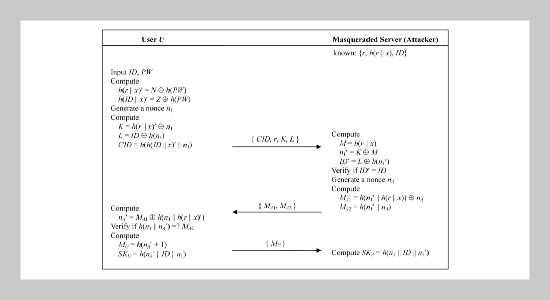REFERENCES
- [1] Lamport, L., “Password Authentication with Insecure Communication,” Communications of the ACM, Vol. 24, No. 11, pp. 770�772 (1981). doi: 10.1145/358790. 358797
- [2] Hwang, M. S. and Li, L. H., “A New Remote User Authentication Scheme Using Smart Cards,” IEEE Transactions on Consumer Electronics, Vol. 46, No. 1, pp. 28�30 (2000). doi: 10.1109/30.826377
- [3] Hwang, M. S., Lee, C. C. and Tang, Y. L., “A Simple Remote User Authentication Scheme,” Mathematical and Computer Modelling, Vol. 36, No. 1�2, pp. 103� 107 (2002). doi: 10.1016/S0895-7177(02)00106-1
- [4] Chien, H. Y., Jan, J. K. and Tseng, Y. M., “An Efficient and Practical Solution to Remote Authentication: Smart Card,” Computers & Security, Vol. 21, No. 4, pp. 372�375 (2002). doi: 10.1016/S0167-4048(02)00415-7
- [5] Fan, C. I., Chan, Y. C. and Zhang, Z. K., “Robust Remote Authentication Scheme with Smart Cards,” Computers & Security, Vol. 24, No. 8, pp. 619�628 (2005). doi: 10.1016/j.cose.2005.03.006
- [6] Shieh, W. G. and Wang, J. M., “Efficient Remote Mutual Authentication and Key Agreement,” Computers & Security, Vol. 25, No. 1, pp. 72�77 (2006). doi: 10.1016/j.cose.2005.09.008
- [7] Liao, I. E., Lee, C. C. and Hwang, M. S., “A Password Authentication Scheme over Insecure Networks,” Journal of Computer and System Sciences, Vol. 72, No. 4, pp. 727�740 (2006). doi: 10.1016/j.jcss.2005. 10.001
- [8] Shieh, W. G. and Horng, W. B., “Efficient and Complete Remote Authentication Scheme with Smart Cards,” Proc. IEEE International Conference on Intelligence and Security Informatics, Taipei, Taiwan, June 17�20, pp. 122�127 (2008). doi: 10.1109/ISI.2008.4565041
- [9] Chung, H. R., Ku, W. C. and Tsaur, M. J., “Weaknesses and Improvement of Wang et al.’s Remote User Password Authentication Scheme for Resource-Limited Environments,” Computer Standards & Interfaces, Vol. 31, No. 4, pp. 863�868 (2009). doi: 10.1016/j.csi. 2008.09.020
- [10] Hsiang, H. C. and Shih, W. K., “Weaknesses and Improvements of the Yoon-Ryu-Yoo Remote User Authentication Scheme Using Smart Cards,” Computer Communications, Vol. 32, No. 4, pp. 649�652 (2009). doi: 10.1016/j.comcom.2008.11.019
- [11] Shieh, W. G. and Horng, W. B., “A Security and Efficiency Improvement of Chung et al.’s Remote Authentication Scheme for Resource-Limited Environments,” Journal of Converge Information Technology, Vol. 8, No. 2, pp. 795�803 (2013). doi: 10.4156/jcit.vol8. issue2.95
- [12] Das, M. L., Saxena, A. and Gulati, V. P., “A Dynamic ID-Based Remote User Authentication Scheme,” IEEE Transactions on Consumer Electronics, Vol. 50, No. 2, pp. 629�631 (2004). doi: 10.1109/TCE.2004.1309441
- [13] Awasthi, A. K. and Lal, S., “Security Analysis of a Dynamic ID-Based Remote User Authentication Scheme,” http://eprint.iacr.org/2004/238.pdf (2004).
- [14] Ku, W. C. and Chang, S. T., “Impersonation Attack on a Dynamic ID-Based Remote User Authentication Scheme Using Smart Cards,” IEICE Transactions on Communications, Vol. E88-B, No. 5, pp. 2165�2167 (2005). doi: 10.1093/ietcom/e88-b.5.2165
- [15] Shieh, W. G. and Chi, Y. H., “A Mutual Authentication Scheme Protecting User’s Anonymity Using Smart Card,” WSEAS Transactions on Information Science and Applications, Vol. 3, No. 6, pp. 1072�1077 (2006).
- [16] Wang, Y. Y., Liu, J. Y., Xiao, F. X. and Dan, J., “A More Efficient and Secure Dynamic ID-Based Remote User Authentication Scheme,” Computer Communications, Vol. 32, No. 4, pp. 583�585 (2009). doi: 10.1016/j.comcom.2008.11.008
- [17] Yeh, K. H., Su, C., Lo, N. W., Li, Y. and Hung, Y. X., “Two Robust Remote User Authentication Protocols Using Smart Cards,” Journal of System and Software, Vol. 83, No. 12, pp. 2556�2565 (2010). doi: 10.1016/ j.jss.2010.07.062
- [18] Khan, M. K., Kim, S. K. and Alghathbar, K., “Cryptanalysis and Security Enhancement of a ‘More Efficient & Secure Dynamic ID-Based Remote User Authentication Scheme’,” Computer Communications, Vol. 34, No. 3, pp. 305�309 (2011). doi: 10.1016/ j.comcom.2010.02.011
- [19] Chang, C. C., Le, H. D., Lee, C. Y. and Chang, C. H., “A Robust and Efficient Smart Card Oriented Remote User Authentication Protocol,” Proc. of 7th International Conference on Intelligent Information Hiding and Multimedia Signal Processing, Dalian, China, Oct. 14�16, pp. 252�255 (2011). doi: 10.1109/IIHMSP. 2011.51
- [20] Wen, F. and Li, X., “An Improved Dynamic ID-Based Remote User Authentication with Key Agreement Scheme,” Computers and Electrical Engineering, Vol. 38, No. 2, pp. 381�387 (2012). doi: 10.1016/j. compeleceng.2011.11.010
- [21] Chien, H. Y. and Chen, C. H., “A Remote Authentication Scheme Preserving User Anonymity,” Proc. of IEEE 19th International Conference on Advanced Information Networking and Applications, Taipei, Taiwan, March 28�30, pp. 245�248 (2005). doi: 10. 1109/AINA.2005.54
















